
Ancient Maya Used Sustainable Farming, Forestry for Millennia
UC researchers used genetic and pollen analyses to provide the most detailed examination to date of the wild and cultivated plants found in the ancient Maya city Yaxnohcah, which was occupied between 1,800 and 3,000 years ago in what is now Mexico’s Yucatan Peninsula.
April 1, 2023 | Source: UC News | by Michael Miller
UC researchers used genetic and pollen analyses to provide the most detailed examination to date of the wild and cultivated plants found in the ancient Maya city Yaxnohcah, which was occupied between 1,800 and 3,000 years ago in what is now Mexico’s Yucatan Peninsula.
A multidisciplinary team of biologists, anthropologists, geneticists and geographers across North America collected and analyzed 38 soil samples, finding evidence of wild trees and plants growing near the city. The research suggests the ancient Maya left much of the rainforest intact. But in other areas, researchers found evidence that the rainforest had given way to savanna dominated by pine trees that persisted for 1,000 years, perhaps from repeated slash-and-burn agriculture or from soil conducive to their growth.
Researchers also found a large diversity of plants the ancient Maya grew for food, fuel, medicine and construction, including maize, chili peppers, squash, manioc (a tuber) and cotton.
